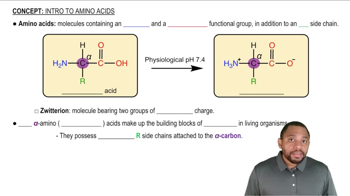In myoglobin, about one-half of the 153 amino acids have nonpolar R groups.
a. Where would you expect those amino acids to be located in the tertiary structure?
 Verified step by step guidance
Verified step by step guidance Verified video answer for a similar problem:
Verified video answer for a similar problem:



 2:7m
2:7mMaster Tertiary Protein Structure Concept 1 with a bite sized video explanation from Jules
Start learning